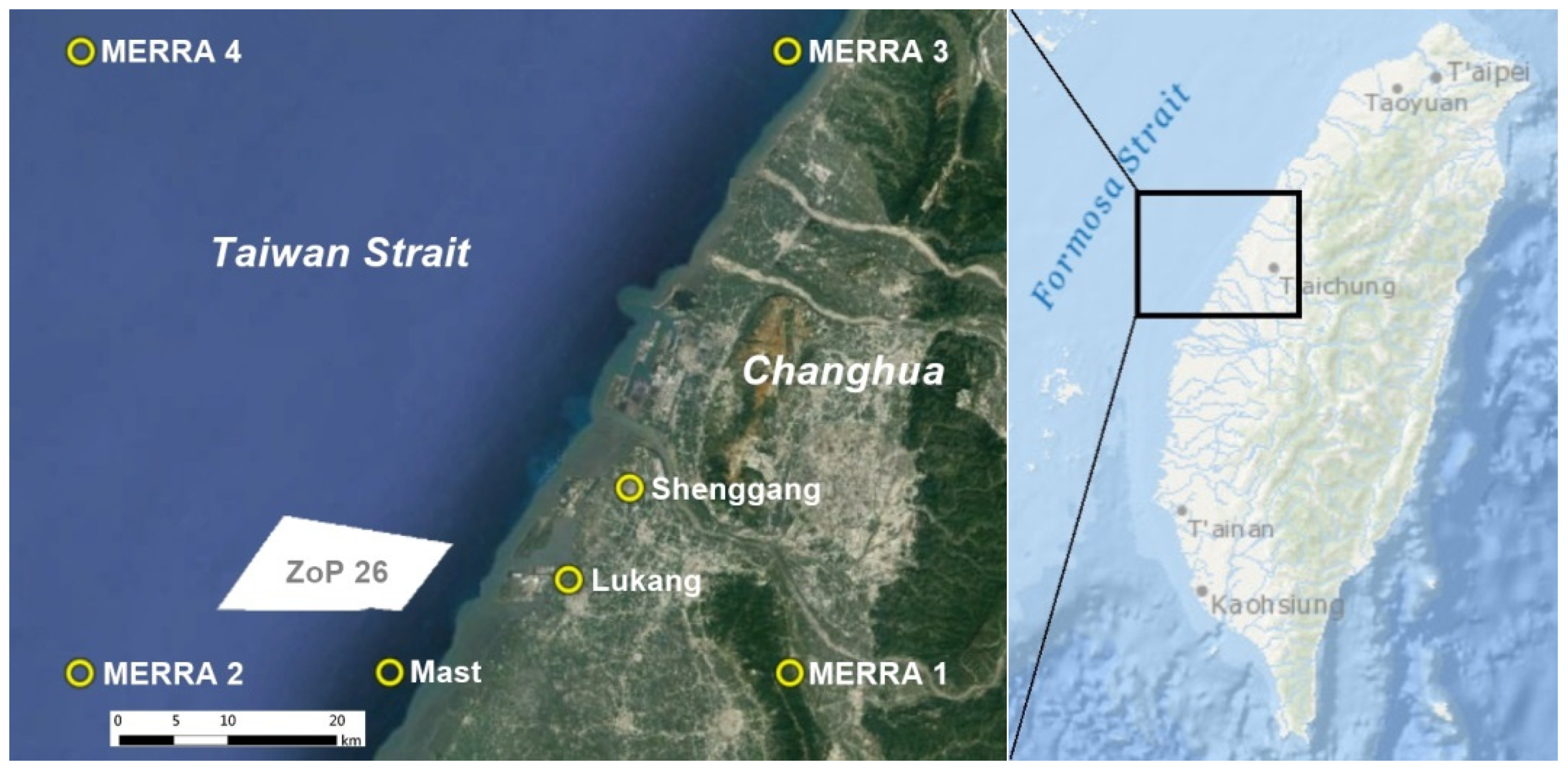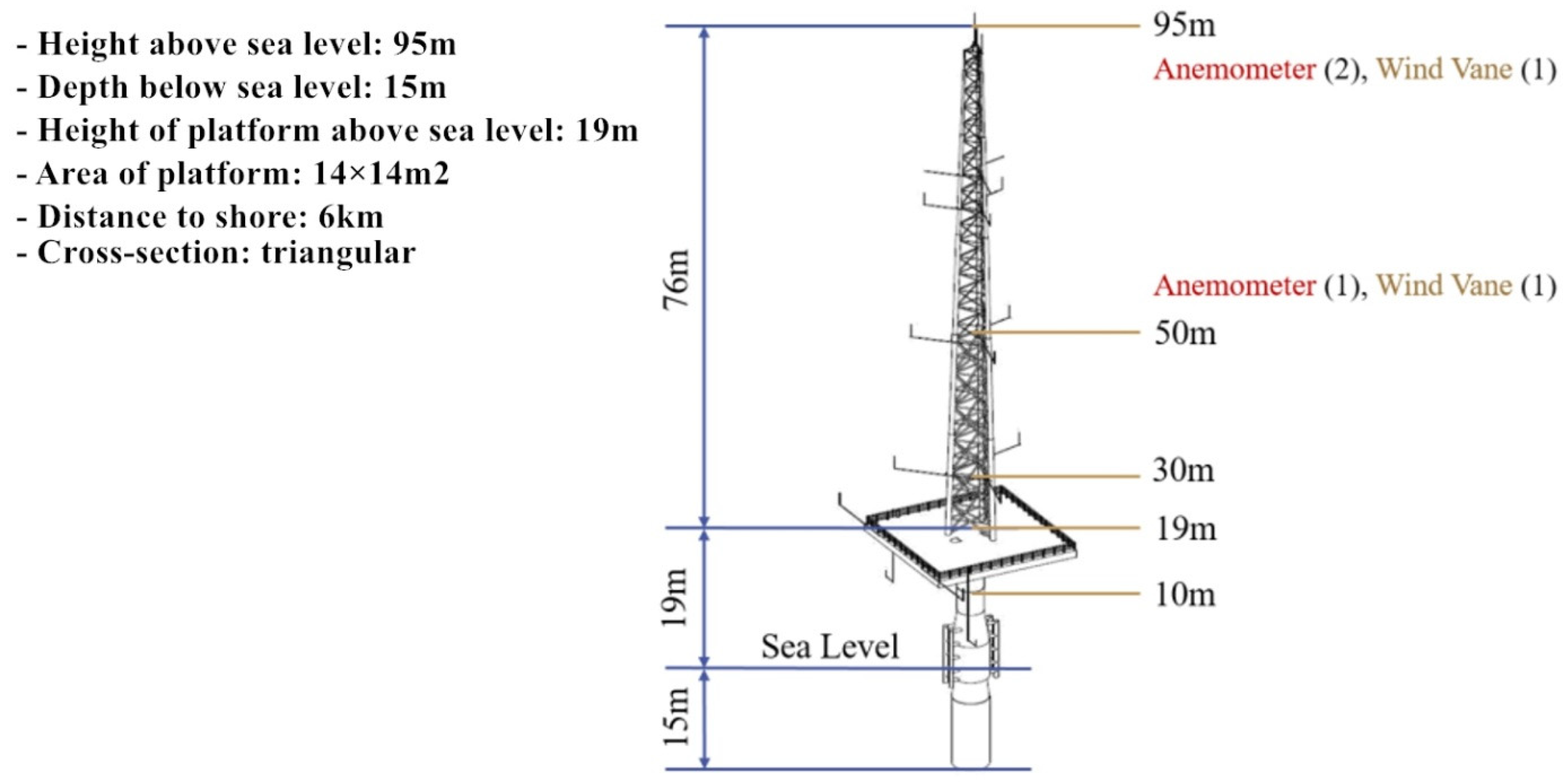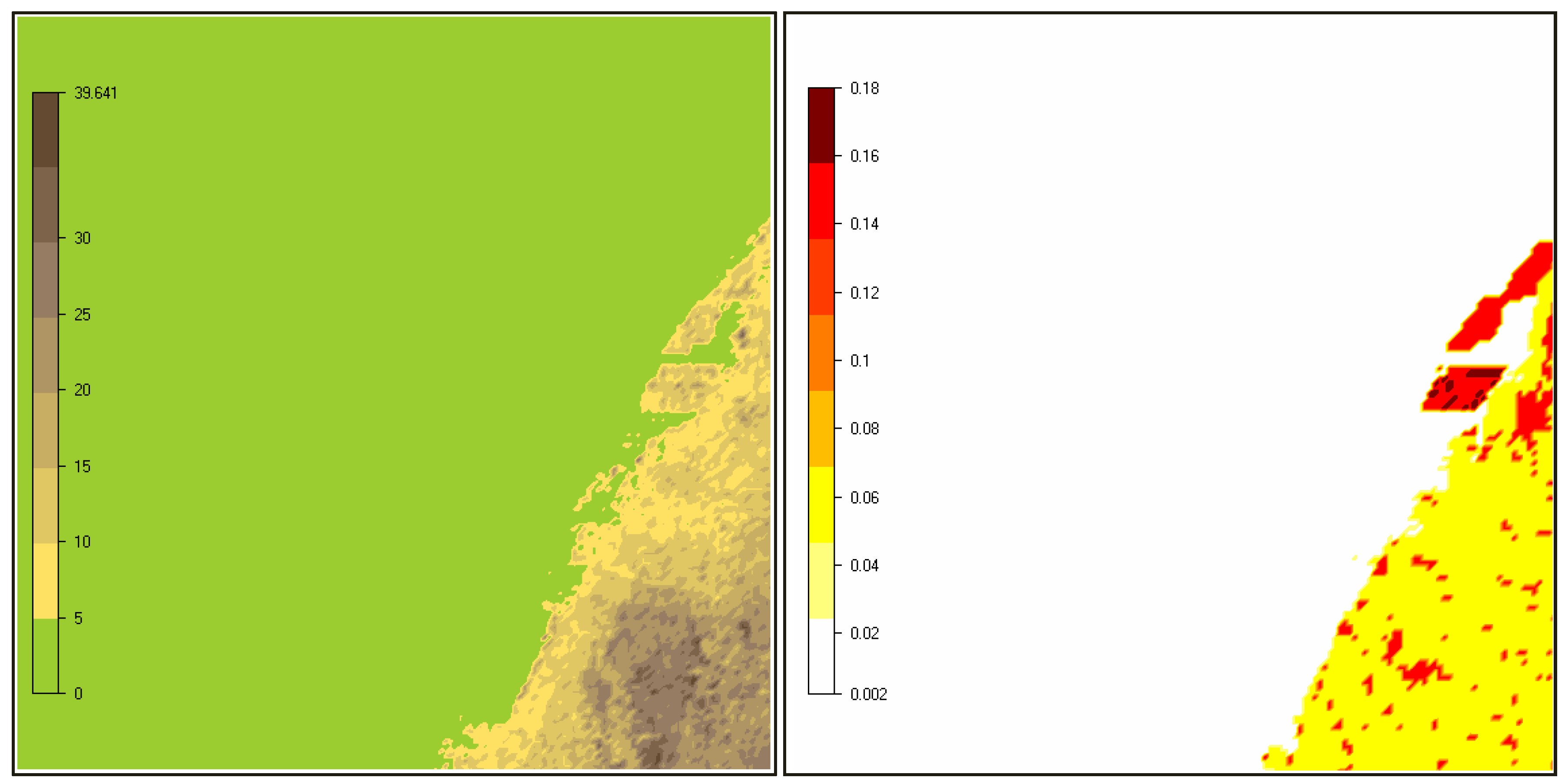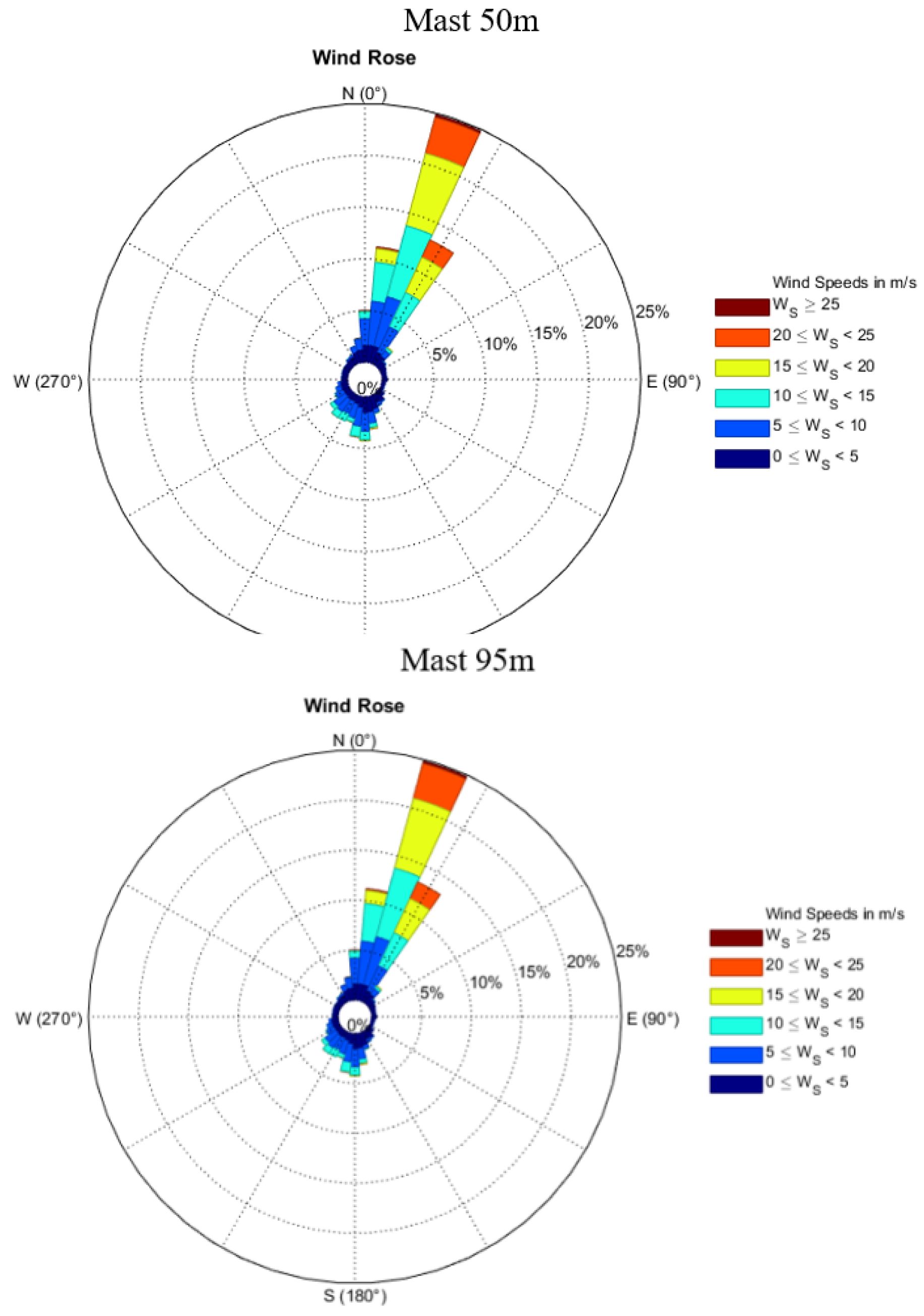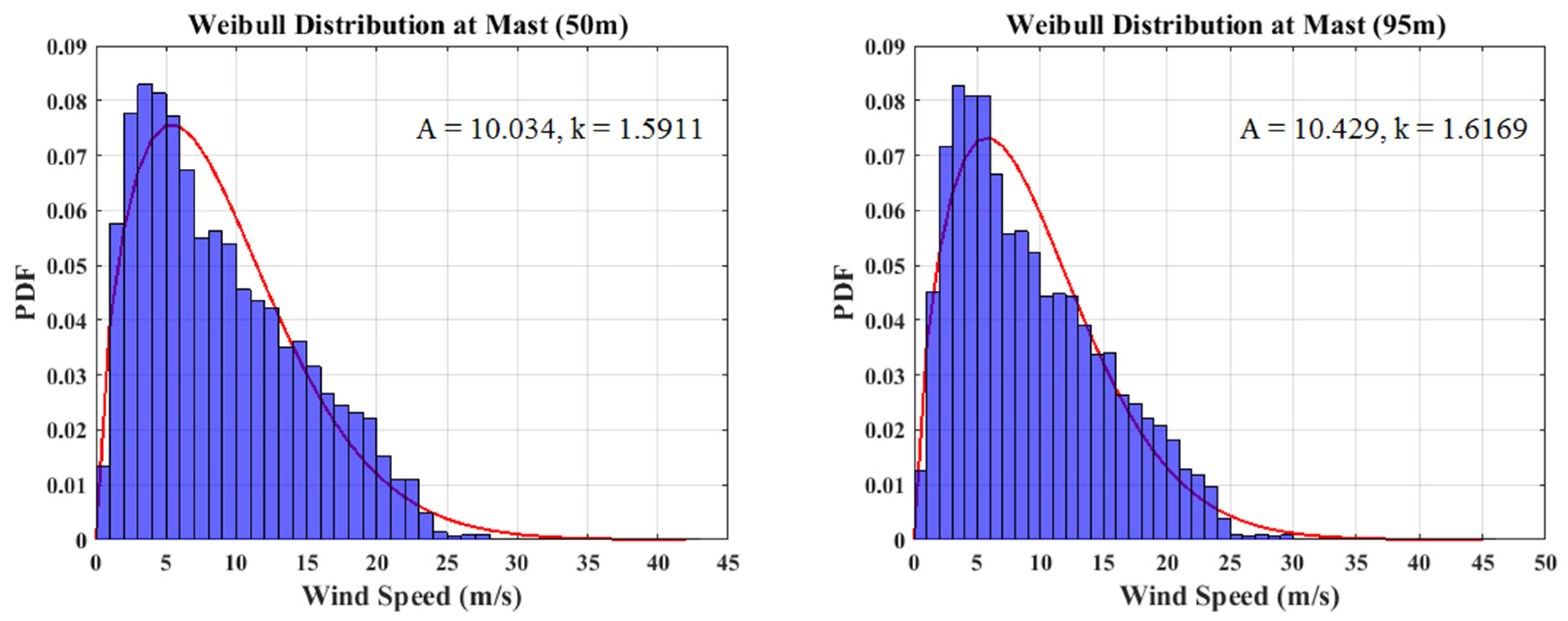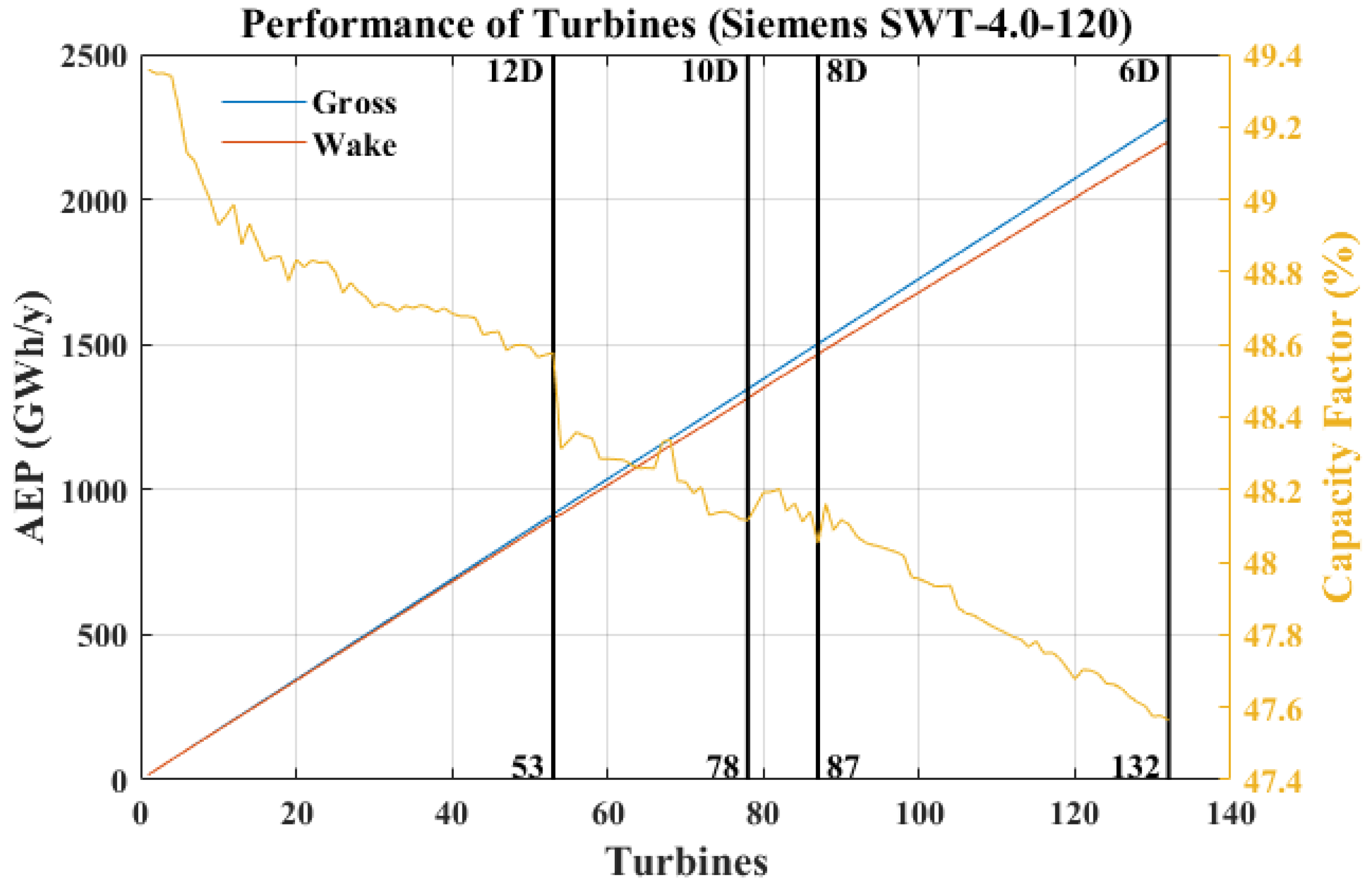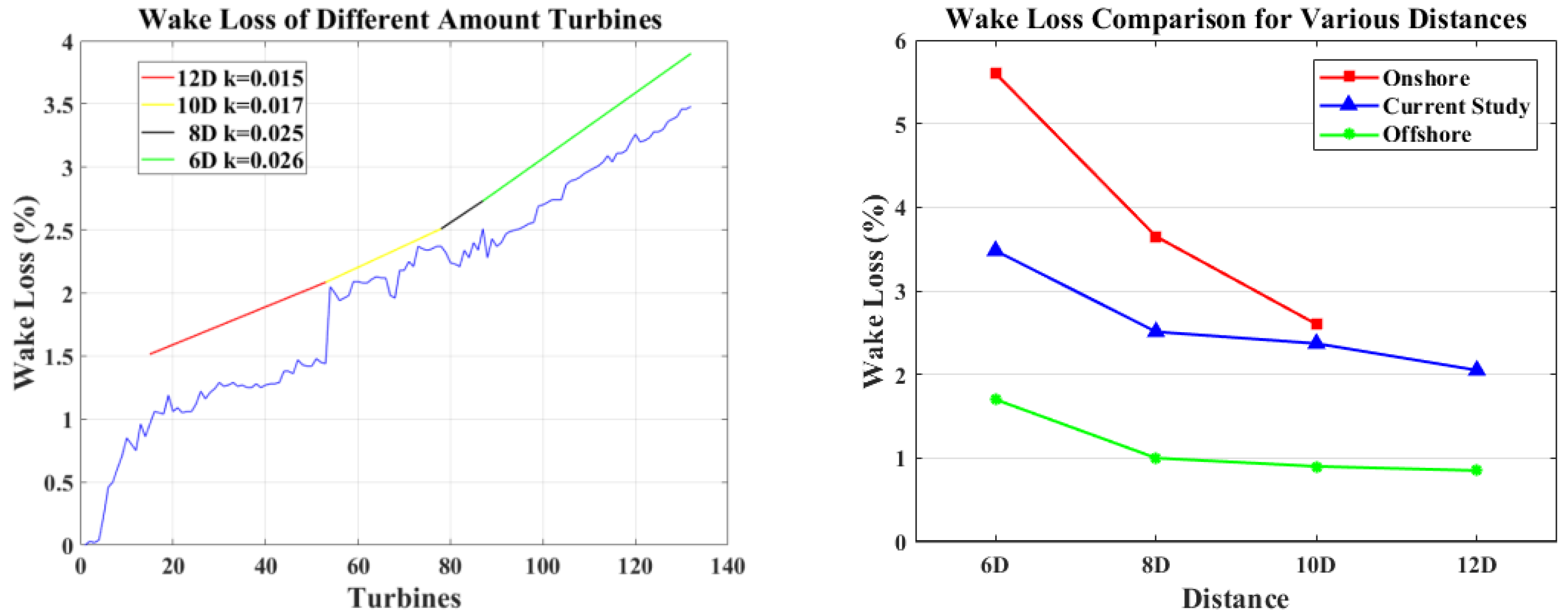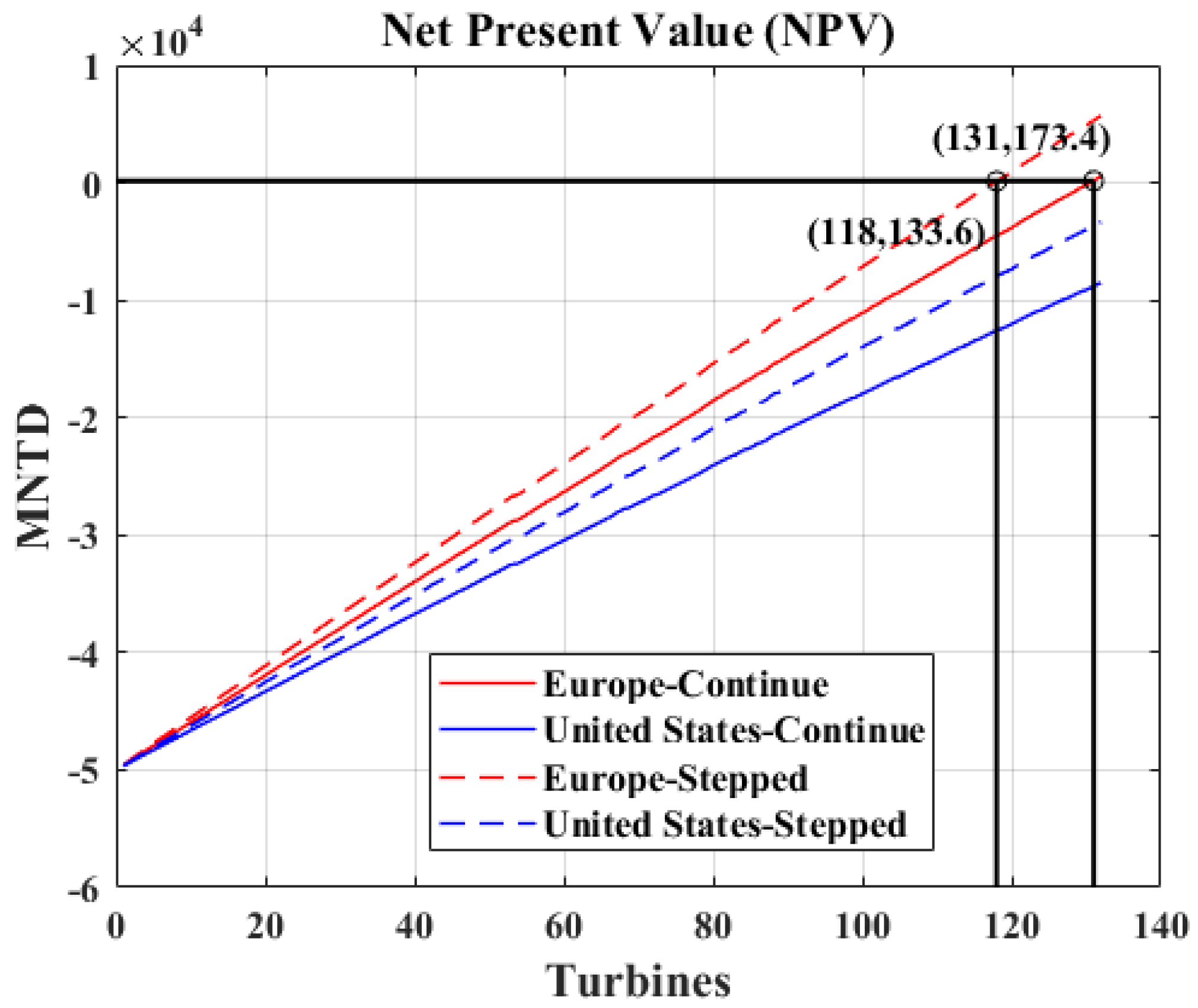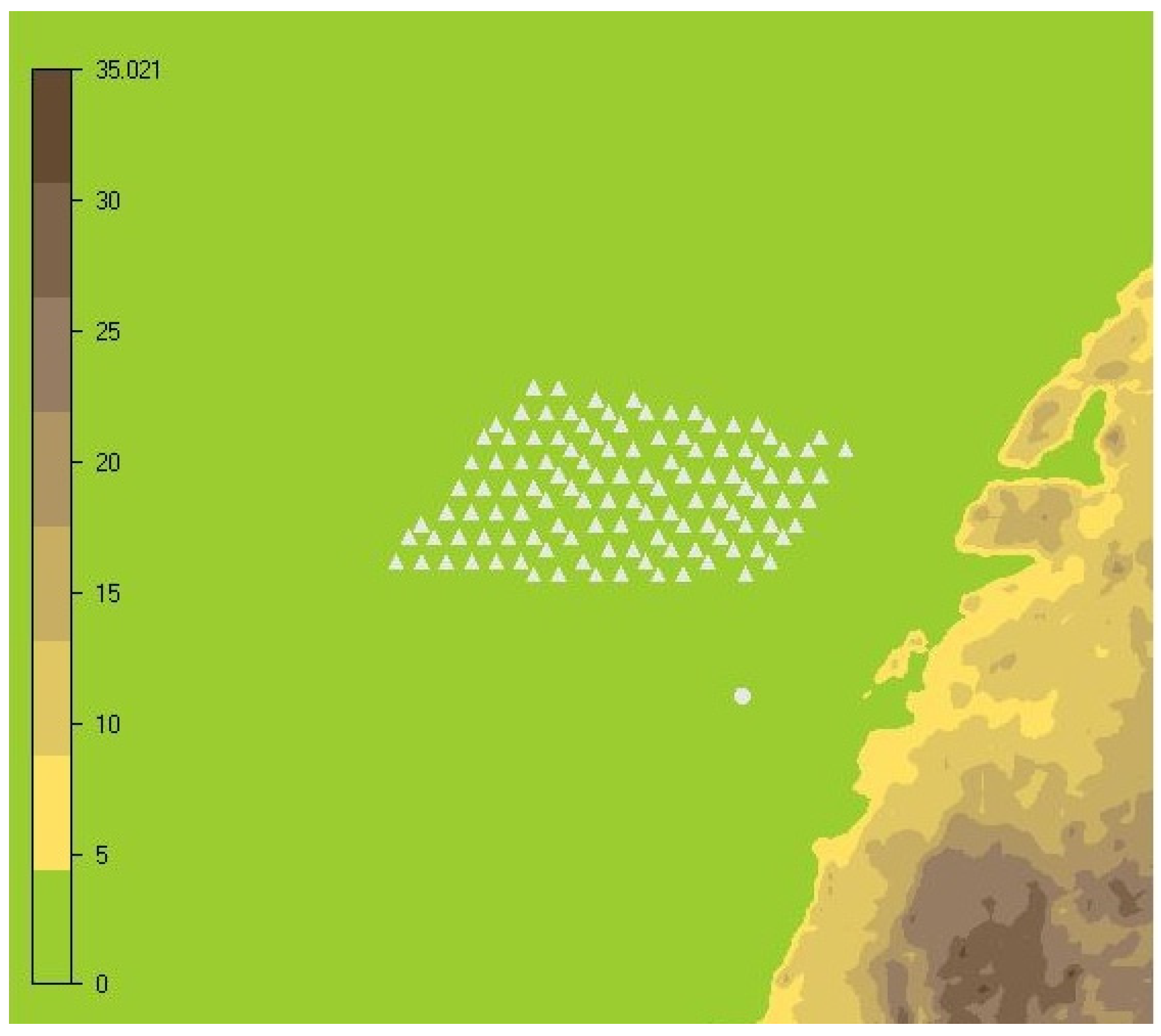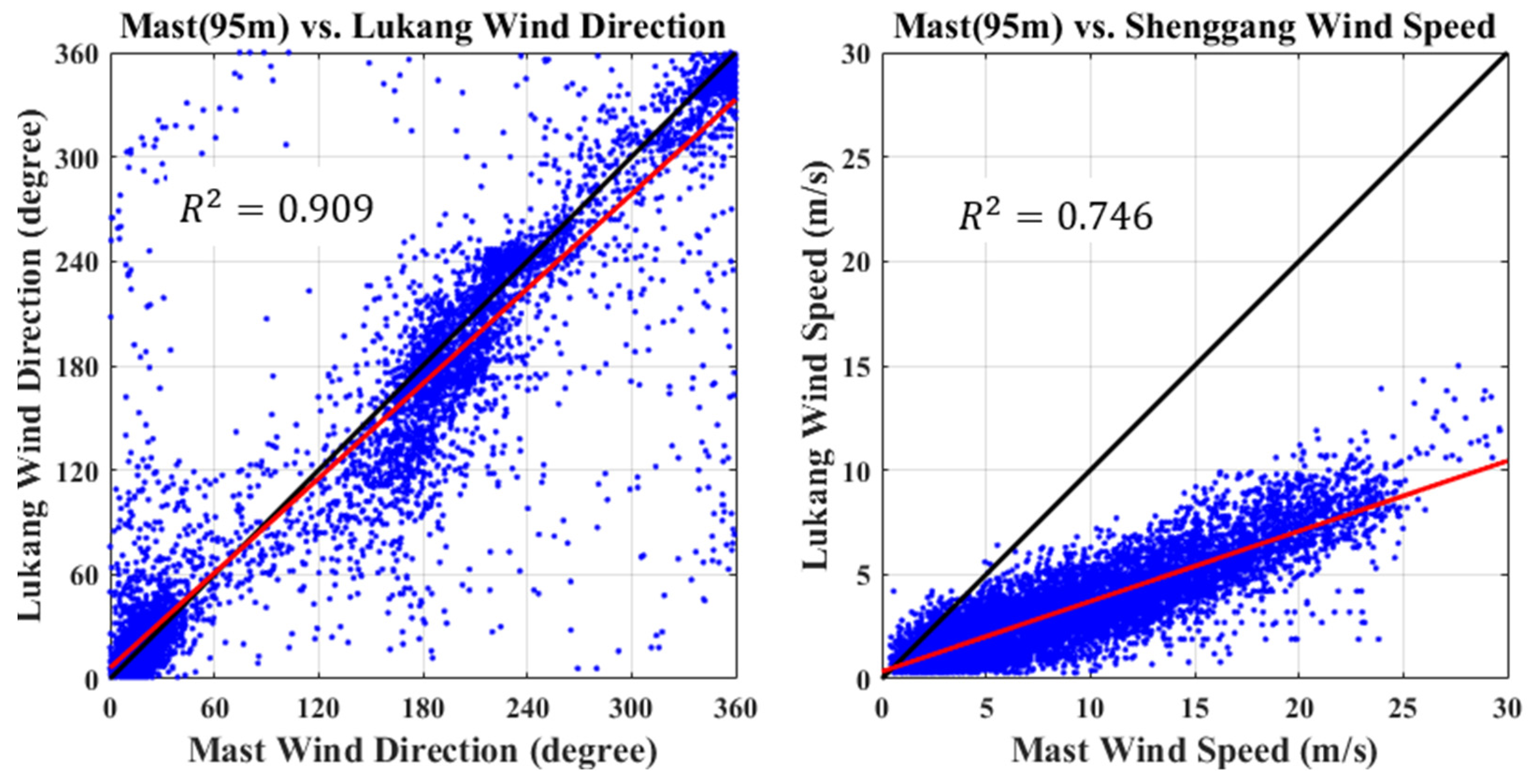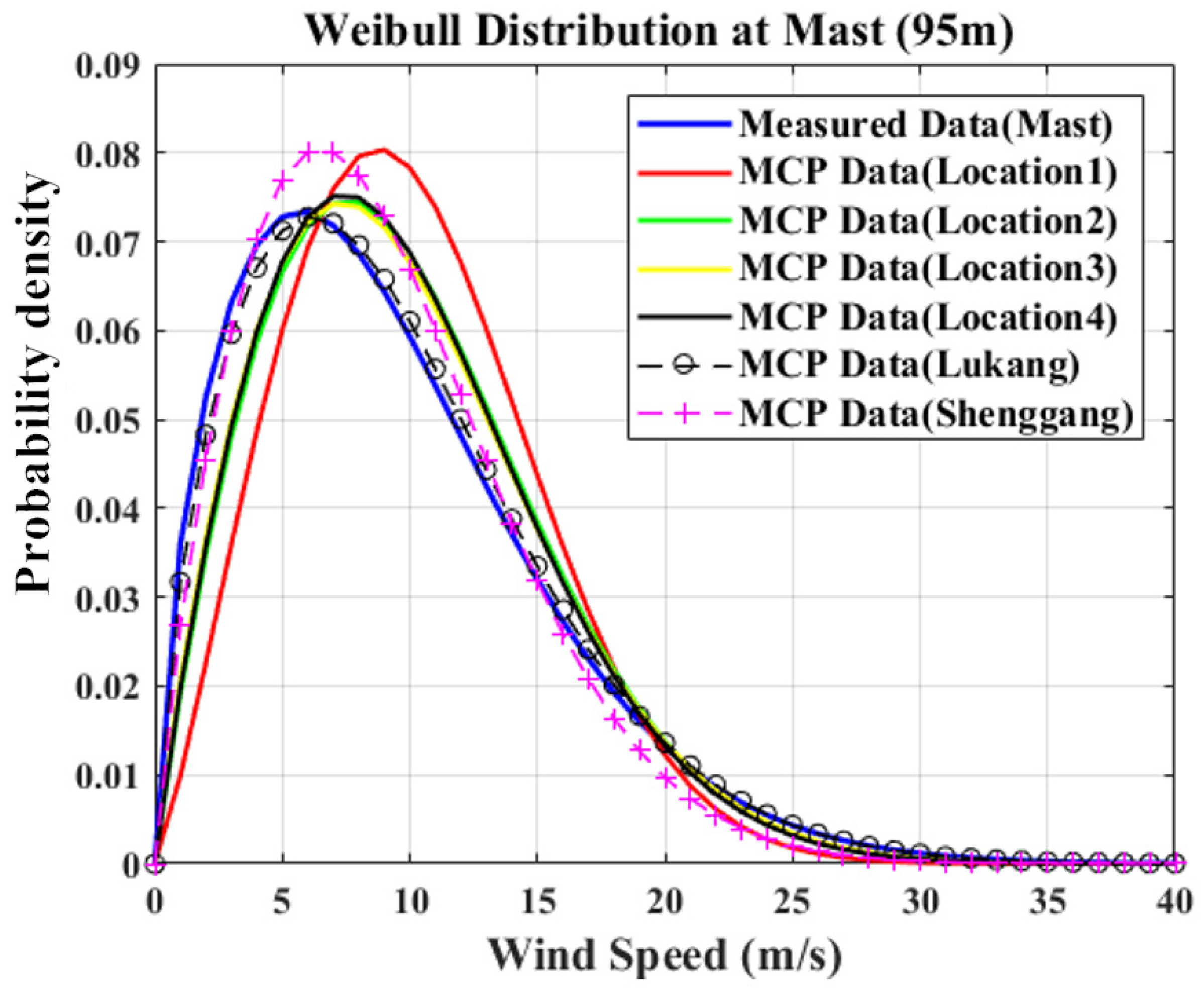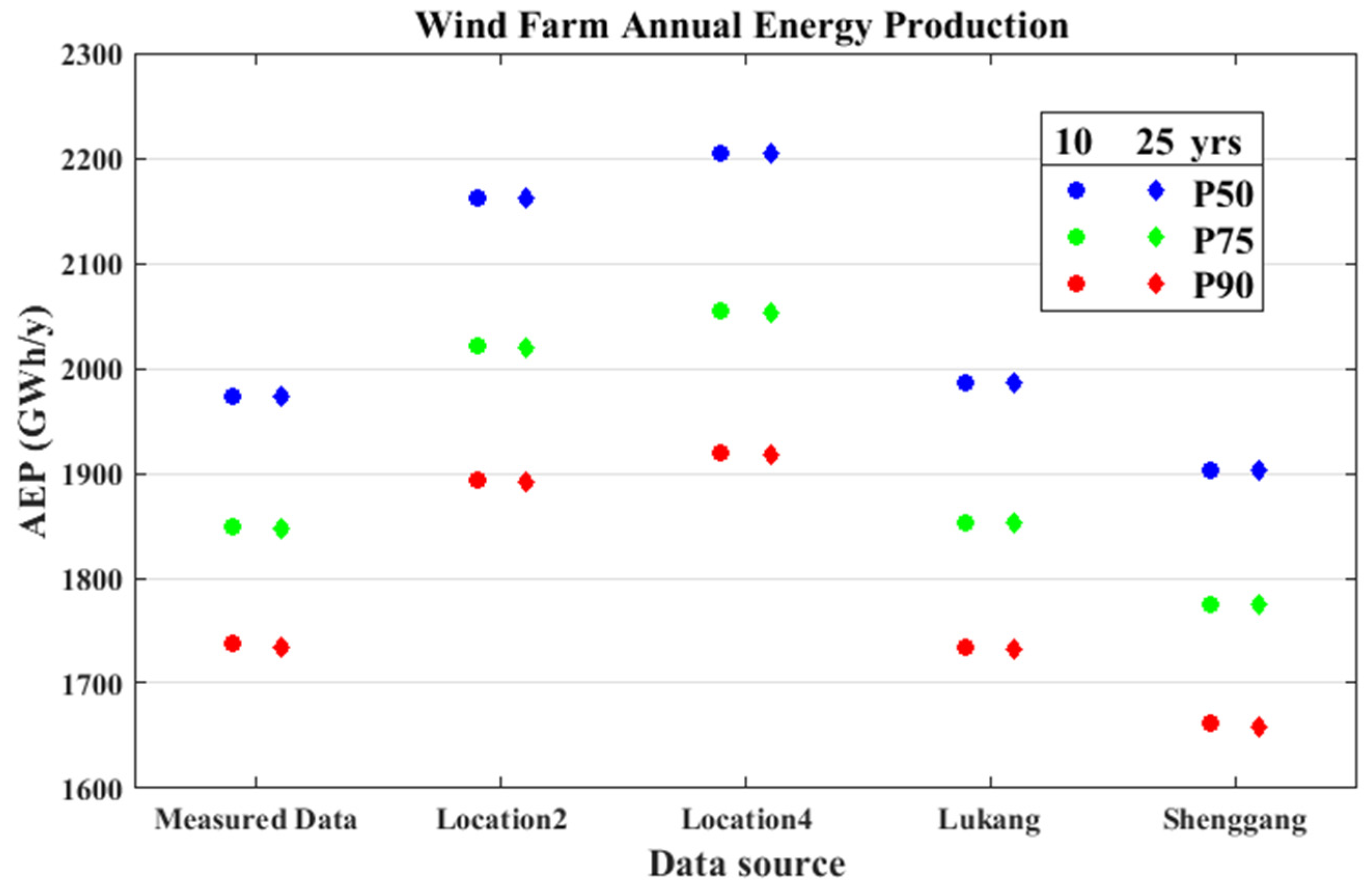1. Introduction
Offshore wind energy is regarded as the backbone that can replace domestic nuclear energy and fossil fuels according to national energy policy of Taiwan. This policy is justified by the fact that the Taiwan Strait has excellent potential for wind energy generation. According to 4C Offshore, 25 projects exist with a 10-year mean wind speed higher than 12 m/s for a hub height of 100 m, and most such projects are located in the Taiwan Strait [
1].
Over the past 20 years, a number of methodologies have been developed to evaluate offshore wind resources. Because of the difficulty of measurement campaigns in offshore areas, the measured wind data for a targeted wind farm often cover only 1 year or even a shorter time. Such limited data sets cannot characterize long-term wind resources. An alternative approach known as measure, correlate, predict (MCP) has been developed to sample long-term wind data at the site of a targeted wind farm. MCP is typically used to relate and adjust on-site measurements to a set of long-term reference data. This process has been widely used in wind energy research [
2], and has become crucial for evaluating regional wind potential at sites that lack local long-term wind data.
The Weibull distribution is widely used as a basis for wind resource evaluation. It is a mathematical function that can represent the wind speed frequency distribution at a site. In the Weibull distribution, the probability density (frequency distribution) represents the number of times in the period of record that the observed speed falls within particular ranges [
3]. The speed bins are typically 0.5 or 1 m/s wide and span at least the range of speeds defined for the turbine power curve from 0 to 25 m/s and above. It is usually presented in reports as a bar chart covering all directions. A study examined the accuracy of Weibull distribution using observation data from three weather stations on three islands near Hong Kong over a period of six years. The result indicated that Weibull distribution had accurately represented the real offshore wind speed frequency [
4].
The capacity factor is often used to assess wind resources at a given site. It is the energy delivered during a period of time expressed as a fraction of the energy that would have been supplied if the plant had operated at its rated capacity. The annual capacity factor is the energy generated during the year (MWh) divided by wind farm rated power (MW) multiplied by the number of hours in the year [
5]. Capacity factors are also affected by the efficiency of the turbine and its suitability for its particular location [
6]. High capacity factors indicate efficient utilization of the generator. The capacity factor is affected by the wind conditions and the turbine’s swept area. A small turbine usually generates relatively low power for high wind speed because of the short length of its blades. Conversely, a large turbine generates more power for a high speed but its cut-in speed is larger than that of a small turbine. With advances in technology, the capacity factor of Anholt 1 offshore wind farm in Denmark reached 52.8%. The average capacity factor of offshore wind farms in Denmark is 41.9% [
7].
For the optimization of offshore wind farm layout, proposed optimization schemes generally prioritize costs [
8]. A study proposed a method of evaluating the net present value of all costs, including initial, construction, operation and maintenance, and retirement costs, and the revenue from selling the produced energy on a life-cycle basis; the Weibull distribution, wind rose, and energy production loss caused by wake loss effects were included in that assessment [
9].
Currently, typical wind resource evaluations are mainly based on historical weather observations, numerical simulation, satellite-based remote sensing, and reanalysis of data [
10]. Historical observations refer to using instruments to measure wind speed and wind direction to characterize the wind resources of a specific site. A problem with this type of evaluation is the limited observation range. Pimenta et al. [
11] used both weather observation data and satellite data sets to evaluate the location, seasonal timing, and availability of wind power resources for the southern coast of Brazil. Meteorological stations measure directly at a high time resolution but low spatial resolution and allow for validation and adjustment of satellite data, whereas satellite data provide near-complete spatial coverage at a lower time resolution.
To overcome the costs and inconveniences of surface-based wind monitoring systems, software-based numerical simulations of microscale wind resources have been developed. Some widely used simulation tools are WAsP, MM5, MesoMap, Site Wind, TAPM, and WEST [
10]. Researchers mostly apply integrated model systems to evaluate wind energy resources; such systems are composed of a mesoscale meteorological numerical model, usually the Weather Research and Forecasting (WRF) model or MM5, and a complex-terrain dynamic diagnosis model, usually the California Meteorological Model or Advanced Regional Prediction System [
12]. Salvação and Soares [
13] used the WRF model to evaluate the offshore wind resources on the Iberian Atlantic coast. A 10-year wind hindcast was simulated with the WRF model at 9 and 3 km of spatial resolution and 6-hourly output. These simulation tools can evaluate wind resources rapidly and economically. However, the selection of boundary conditions and parameters can lead to inaccurate conclusions that bear little resemblance to real situations. Over the past 20 years, software for evaluating wind energy has improved enormously; such software now offers computational fluid dynamics (CFD), finite element analysis, and numerical modeling. Such simulations involve wind farm siting, wind farm modeling, prediction, and other items [
14].
Satellite-based remote sensing systems have been developed to gather information about the Earth. This type of measurement can monitor the Earth on a long-term and large-scale basis without being restricted by terrain. During 2004–2006, the Risø National Laboratory in Denmark and several other research institutions conducted the SAT-WIND research program and confirmed the potential of applying satellite-derived data, including surface wind distribution data derived from passive microwave remote sensors, altimeters, scatterometers, and synthetic aperture radars (SARs), to offshore wind energy resource evaluation. The results showed that it was feasible to evaluate offshore wind energy resources using satellite-derived wind speed distributions. Charlotte et al. [
15] used ocean surface wind speed data derived from SARs to study wind energy resources over the Baltic Sea. They compared the wind speed data derived from SARs with observational surface wind speed data and found that the SARs exhibited higher accuracy. However, such measurements are limited by (1) low time resolution (e.g., 14 of 17 satellites in the Danish SAT-WIND project record observations less than once a day); (2) low horizontal resolution, with a general satellite data resolution of 25 km × 25 km, except for SARs achieving finer spatial resolution; (3) low accuracy (e.g., wind speeds estimated by QuikSCAT satellite-based remote sensing are overestimated with an average deviation of 1.00–3.63 m/s); (4) and few options for height of observations (wind flow at 10 m may be provided by satellites that cannot depict wind flows at different heights) [
3,
10].
Various reanalysis data sets have been developed to provide high quality, long time scales, and regular grid points. In the mid-1990s, the US National Center for Environmental Prediction (NCEP) collaborated with the National Center for Atmospheric Research (NCAR) to develop the first-generation reanalysis data product NCEP-R1 [
16]. The European Center for Medium-range Weather Forecast (ECMWF) subsequently published its first-generation reanalysis data product, ERA-15. The NCEP and ECMWF launched their second- and third-generation reanalysis data products during the 2000s [
17,
18,
19].
Reanalysis data sets are created using historical weather observations to drive a global or regional NWP model. From these model runs, weather parameters are extracted for every grid point and every level in the model. Reanalysis data sets are created to support climate studies. Through statistical analysis of 10-m NCEP/DOE Reanalysis wind data from 1979–2010, Chadee and Clarke [
20] derived a regional annual wind resource map, which showed that the Caribbean low-level jet region was an area with superb wind power density. They also identified the eastern Caribbean and the Netherlands Antilles as locations with excellent wind energy resources.
Reanalysis data have a number of positive attributes, including convenience, multiple levels and types of weather parameters, and a long data record. Because the gridded data are available for everywhere covered by the model, it is easy to locate suitable grid points. This eliminates much work searching for surface weather stations and data sets, and it provides a common data source for all MCP studies. In parts of the world where surface weather observations are unreliable, reanalysis data may be the only feasible source of reference data for MCP. However, reanalysis data also have significant disadvantages and must be used with caution. First, the correlation of the reanalysis of winds with tower observations depends on the complexity of the terrain and the resolution of the reanalysis model. The NCEP/NCAR global reanalysis data set is relatively coarse, with a resolution of about 2° in latitude and longitude (slightly over 200 km) and thus may provide poor results in mountainous terrain, at coastal boundaries, and in other places where sharp wind gradients exist. More importantly, the homogeneity of reanalysis data is limited by that of the observational system used to drive the model; observational systems have changed dramatically over the decades. The bulk of the weather observations in the 1950s and 1960s came from weather balloons supplemented by land- and ship-based surface observations. Weather satellites became increasingly important in the 1970s and 1980s, decades that were marked also by a large increase in the frequency of weather observations from both surface and radiosonde stations [
11].
Concerning the evaluation software of wind energy, the first WAsP developed has been widely used in wind energy research. Measured wind data were used on the Turkish west coast from 1975 to 1984 to estimate wind resources using WAsP [
21]. Another study evaluated wind conditions in the Danish offshore area of the Baltic Sea using WAsP and two measurement stations on Lolland Island. The result indicated that the WAsP simulation roughly conformed to wind conditions, except that its prediction slightly overestimated wind speed [
22]. A study combined ArcGIS with WAsP to estimate wind resource distribution using ArcGIS to overlay WAsP’s estimates of the average wind speed and power density on a map of the studied region to determine the most suitable sites for installing wind turbines [
23].
To reduce the deviation of wind resource evaluation caused by complex terrain, researchers have used CFD for relatively accurate simulation. The most widely used CFD-based software products for wind farm design are Meteodyn WT and WindSim. A study used mesoscale wind data and Meteodyn WT to evaluate the wind conditions on Phaluay Island in Thailand with a spatial resolution of 90 m × 90 m. The result accurately conformed to the mesoscale wind data [
24]. Another study used Meteodyn WT to evaluate a wind farm on complex terrain. The result indicated that the wind resource evaluation of Meteodyn WT roughly conformed to measured data, but the simulation of extreme wind speed was relatively conservative [
25]. WindSim can solve nonlinear equations of mass, momentum and energy; thus, it can simulate places with complex terrain and complex local climatic conditions. Researchers built more than 120 terrain models from data of heights and roughness covering the Norwegian coast from southern Lindesnes to the northern boundary with Russia and subsequently used WindSim to evaluate wind resources on the Norwegian coast [
26]. According to a number of scientific research studies and practical engineering experiments, CFD-based calculation software can simulate wind resources more accurately than WAsP [
27,
28,
29].
The accuracy with which a wind farm’s power generation can be estimated and predicted deeply influences the financial evaluation of the wind farm under consideration. Until now, because of the inconvenience of wind measurement in offshore areas, wind companies have mostly used mast and LiDAR methods to gather wind data. However, in some offshore areas, it is difficult for a LiDAR installation to survive extreme weather conditions long enough to gather representative data for wind resource evaluation. Considering that the offshore Zone of Potential (ZoP) 26 wind farm of Taiwan will be exploited in the future, in the present study, we aim to evaluate wind resources and optimize the design of the ZoP 26 wind farm by using data from mast, Modern-Era Retrospective Analysis for Research and Applications (MERRA), and weather stations. First, the power generation potential of the ZoP 26 wind farm is estimated (
Figure 1). Second, the number of turbines in the target wind farm is optimized based on economic analysis. Finally, the probability of prediction of annual energy production (AEP) is evaluated based on the estimated uncertainty.
2. Materials and Methods
2.1. Measurement Setup
The measurement locations considered in the present study are in the Changhua nearshore area of Taiwan (
Figure 2). The Taipower mast is located 6 km from the coast. The height of the Taipower mast is 95 m above sea level, and the depth is 15 m below sea level (
Figure 3). The height of the platform is 19 m above sea level. Three booms stretch out from the mast along the directions of 30°, 150°, and 270°. Considering the characteristics of wind resources in Taiwan with the northeast monsoon in winter and southwest airflow in summer, an anemometer and a wind vane are installed on the boom at 150°.
The cup anemometer and wind vane installed on the mast conform to the IEC 61400-12-1 Class 1. The permissible ambient temperature range for their operation is −50 °C to 80 °C. The anemometer can measure wind speeds of 0.3 m/s to 70 m/s with an accuracy of less than 0.2 m/s. The wind vane can measure angles of 0° to 360° with an accuracy of 1°.
The data measured by these instruments were collected with a data logger inside a container on the platform. The signal was transmitted by a microwave antenna on the mast. The receiver was installed on the roof of the Wanggong substation. The data were stored in a computer in the substation. A diesel generator was used to power the crane. Nine solar panels were used to supply power to the anemometer, wind vane, atmospheric pressure gauge, thermohygrometer, and data logger.
2.2. Datasets
The data sources used in this study are as follows: Taipower mast, MERRA, and Central Weather Bureau (CWB). Ideally, data sets should span at least 1 year of measurement, and cover an integer number of years to reflect the full seasonal cycle of wind variations. Hourly or 10-min wind speed and wind direction data are usually used. The Taipower mast started its measurement campaign on 1 April 2016; therefore, data from 1 April 2016 to 1 April 2017 were used in this study. MERRA and CWB Lukang data from 1 April 2011 to 1 April 2017, and CWB Shenggang data from 1 April 2012 to 1 April 2017 were used in this study. Although the Shenggang station began measurement in February 2011, it did not transmit data until 1 November 2011. The used data period thus starts from 2012 and contains a full year of data. Because the MERRA and CWB data have a resolution of no more than 1 h, hourly data from the Taipower mast, MERRA, and CWB were used in this study to ensure a consistent resolution for all data sources.
MERRA is an analysis method designed by NASA. The MERRA dataset spans the period from 1979 through 2016. The present study used data of MERRA version 2 (MERRA-2), which was started in 1980. MERRA and MERRA-2 are based on the GEOS-5 atmospheric data assimilation system, but additional advances to the GEOS model and the Gridpoint Statistical Interpolation assimilation system are included in MERRA-2. The MERRA data structures used in the present study are composed of four grid points (
Figure 2). The MERRA data were simulated at a height of 50 m.
The Central Weather Bureau (CWB) data were obtained through the Central Observation Data Inquiry System (CODiS). The instrument used by CWB for measuring wind speed and wind direction is a propeller-type wind anemometer. The wind direction provided by CODiS is 0° when the wind speed is lower than 0.3 m/s. CODiS shows hourly wind speed data with an accuracy of one decimal place and shows the wind direction angle as an integer value. CODiS data from the Lukang and Shenggang stations, located at altitudes of 17 m and 24 m, respectively, were used in this study.
2.3. MCP
MCP is used to perform long-term hindcasting of wind resources at a target site with only short-term wind data. Various periods have been suggested for long-term data, such as three years [
30], 10 years [
31], and longer [
32]. The long-term data series must coincide in the time series with the short-term data. Moreover, for such long-term data, the use of hourly data may be more suitable than the use of 10-min average wind data [
33].
In the MCP method, the wind speed relationship between the target data and reference data would be reliable in the presence of a strong wind direction relationship between the target data and reference data. Correlation coefficient (R
2) values in the ranges of 0.5–0.6, 0.6–0.7, 0.7–0.8, 0.8–0.9, and 0.9–1.0 are considered very poor, poor, moderate, good, and very good [
34]. To express the characteristics of wind resources at the target site, data of at least a year should be used [
35,
36]. By using the relationship of coincident time period between the target data and reference data, unavailable target data can be synthesized from the reference data.
2.4. AEP
AEP is usually calculated as follows:
where
is the number of hours in a year (=8760), and
and
are the Weibull distribution and the power output, respectively. The wake effect and the number of turbines must be considered when assessing the energy produced by a wind farm.
2.5. WindSim Model
WindSim is a wind farm design tool that can be used to build a numerical model of terrain by using elevation and roughness data. The code is based on the numerical core PHOENICS, which solves the Reynolds-Averaged Navier-Stokes (RANS) equation [
37]. The equation can be used with approximations based on knowledge of the properties of flow turbulence to obtain approximate time-averaged solutions of the Navier–Stokes equation. The equation can be written as follows:
where
represents the change in the mean momentum of the fluid element,
represents mean body force,
represents isotropic stress due to the mean pressure field,
represents viscous stresses, and
represents the Reynolds stress.
This equation is solved using computational fluid dynamics (CFD). Convergence of this equation with the Reynolds stress term is difficult, so a turbulence model is usually added. Before the CFD calculations, the domain is built based on the elevation and roughness of the target site.
In offshore areas, farm dynamics are mainly driven by wakes. WindSim is suitable for application to offshore test cases [
38]. Compared to other software packages, WindSim has high consistency in terms of the topographic effect, and assessment results obtained using WindSim have been found to differ by 1% from real production data [
39]. The rotor of a wind turbine is modeled as an actuator disc [
40], which is applied to model the wakes of wind turbines in combination with RANS simulations [
41].
In the simulation process of WindSim, terrain and wind data are imported. Thereafter, the boundary conditions and parameters of the turbine are set up.
2.5.1. Terrain Setup
In the present study, we employed ASTER GDEM v2 Worldwide Elevation Data with a resolution of 1 arc-second (approximately 30 m) to establish elevation data for the Changhua nearshore area. The roughness data were obtained from GlobeLand30 with a resolution of 30 m. The data contained in ASTER GDEM v2 Worldwide Elevation Data and GlobeLand30 were recorded using the WGS84 coordinate system. These two data sources were imported into the Global Mapper used to convert WGS84 into the UTM 51N coordinate system and combine the two data sources into a GWS file for import into WindSim. The elevation and roughness of terrain of the Changhua nearshore area are illustrated in
Figure 4.
To ensure that the AEP calculation converged, the mesh of the terrain was calculated from 184,960 to 961,000 cells (
Table 1), with the height layers set at 40 cells.
2.5.2. Boundary Conditions
The parameters for boundary condition adopted in this study are listed in
Table 2. The general collocated velocity (GCV) method was used as the solver. With GCV, solutions converge even for uneven grid architectures and steep terrain. For complex terrain, a fixed pressure is used as the top boundary. Because the region considered in this study is near the shore (flat terrain), a no-friction wall was used as the top boundary. The standard k-ε turbulence model contains two equations.
For turbulent kinetic energy k:
For dissipation
:
where
represents the velocity component in the corresponding direction,
represents the component of rate of deformation, and
represents eddy viscosity.
Lu et al. [
42] reported heights of the mixed layer for various geomorphic features in Taiwan; the heights of the mixed layer ranged from 800 to 1100 m, except in mountain areas. In the present study, 1000 m was selected as the boundary layer height. The velocity of air above the boundary layer was calculated using the power law and log law. The limits for the power law and log law are generally under ABL (i.e., below 2000 m). In the altitude range of 30 < z < 300 m, the best fit is obtained using the power law [
43]. At altitudes lower than 200 m, the best fit is obtained using the log law. Drew et al. [
44] indicated that the profile calculated using the power law shows better fit at altitudes of 500–1000 m. The altitudes considered for calculating the parameters of the log law and the power law were 50 and 95 m, respectively.
Wind data of a full year at mast heights of 50 and 95 m were used in the energy generation calculation. Wind rose illustrated that the strong wind mainly originated from north-northeast (
Figure 5), which is in accordance with the dominant northeast monsoon in winter. The values of the shape parameter (k) of the Weibull distributions for 50 m and 95 m were 1.5911 and 1.6169, respectively (
Figure 6), which means the distribution at 95 m was closer to that of a higher wind speed than that at 50 m.
2.5.3. Wind Turbine
A Siemens SWT-4.0-120 turbine, which conforms to IEC Class IA, was used in this study to evaluate the potential of wind power generation because two turbines of this type were erected in 2016 as demonstration offshore wind turbines in Taiwan. The rated power output of one such turbine is 4 MW at a rated wind speed of 16 m/s. The rotor diameter is 120 m, and the swept area is 11,300 m2.
2.5.4. Park Optimization
WindSim optimizes park layouts by identifying turbine locations with the highest wind speeds but low turbulence to maximize energy production while minimizing turbine load problems. The wake effect is the main parameter in park optimization. The Jenson model was used as wake model used in this study. The decay coefficient,
, was set to 0.05 for the offshore condition [
45]. With the input of velocity scalar XY, velocity scalar Z, and inflow angle and turbulence intensity at hub height and blade tip height, the Park Optimizer module was used to optimize the wind farm. The limitation of the IEC standard is summarized in
Table 3. The Park Optimizer considered the terrain condition, inflow angle, turbulence intensity, and velocity for setting the limitation for turbines. The Park Optimizer calculates the best locations for different numbers of turbines by determining the inter-turbine distance required to avoid the wake effect. For determining turbine locations, inter-turbine distance is calculated with the limitation and the wind resource map, which the files export after performing the CFD calculation and importing terrain data and wind data. The results of the Park Optimizer are the energy production affected by wake effects and turbine coordinates.
2.6. Uncertainty in Wind Resource Assessment
Numerous factors influence the forecasting results, such as performance of numerical weather prediction, power curves, and measurements. Wind resources can be classified as historical and future resources. Historical wind resources usually present an uncertainty of 3% to 6%. Without a reference data source or in the absence of thorough data analysis, the uncertainty for one year of measurement is assumed to be 4% [
3]. For future wind resources, uncertainty is calculated as follows:
where
Np is the number of the years used for estimating uncertainty in the future, and
σ is the uncertainty for a year. The uncertainty due to climate change ranges from 0.5% to 2%. Brower et al. indicated that the uncertainty is 0.5% when
Np equals 10 years and 2% when
Np equals 25 years [
3].
For long-term wind prediction, uncertainty is based on the correlation coefficient of the wind speed between the target site and the reference site. Correlation coefficients greater than 0.9, between 0.9 and 0.8, and between 0.7 and 0.6 indicate wind speed correlation uncertainties of less than 1%, between 1% and 2%, and between 3% and 5%, respectively [
46].
The power curve is one of main sources of uncertainty. The power output is given for steady wind conditions, while power cannot be generated as ideally as shown by the curve. The main causes of uncertainty are turbulence, air density, and the shear characteristics of the site. The uncertainty of a power curve is usually 6% [
47].
Various parameters pertaining to uncertainty have been used to forecast the probability of energy production. P50 represents a 50% probability that a given amount of energy will be generated [
48]. The probability of energy production for probability
x,
Px, is as follows:
where
z is the value of normal distribution for a specific probability.
2.7. Economic Evaluation
The number of turbines and their coordinates were obtained using the Park Optimizer. An economic evaluation was conducted to determine the value of the wind farm. The costs of a wind farm include capital and operational expenditures (
Table 4). Because Taiwan currently has no commercially operating offshore wind farms, expenditures of offshore wind farms in the United States [
49] and Europe [
50] were used to conduct economic evaluation of offshore wind farms in the present study.
The offshore wind power purchase price in Taiwan decreased slightly from 2017 to 2018 owing to a decrease in costs (
Table 5). Calculation results obtained based on this price can be used to estimate whether the development of a wind farm is worthwhile in terms of the values of net present value (NPV) and energy cost.
2.7.1. Net Present Value
The NPV represents the difference between the present value of cash inflows and cash outflows over a period of time for an investment. The general formula for calculating NPV is as follows:
where
is the net cash inflow during the period
t,
is the total initial investment, and
r is the discount rate.
The formula used in this study is as follows:
where
is the fixed cost,
is turbine costs,
represents variable costs such as cabling and foundation costs, n is number of turbines,
is power generation,
is price of power sales, and
is operational cost. The values of
and
vary with time. The values of sales or cost for the first year are considerably greater than the corresponding values for the last year.
An investment with a positive NPV is generally regarded as profitable. Based on 4C Offshore data, the target wind farm requires an investment of 4.700 billion US dollars (137.6 billion NTD). The fixed cost , which includes the costs of transformers, wharves, grid connections, and other costs not related to turbines, was estimated as the difference between the total investment and capital expenditure; it was calculated to be 50 billion NTD.
2.7.2. Cost of Energy
The cost of energy is the price of generating energy. The formula used to determine it in this study is as follows:
where the parameters are the same as those for NPV.
4. Conclusions
In the present study, we employed multiple data sources to evaluate wind resources and to optimize wind farm design. The vital wind farm optimization findings and energy production predictions are as follows.
When the distance between the turbines in a wind farm was decreased from 12D to 6D, the turbine number increased from 53 to 132, while the capacity factor decreased slightly from 48.6% to 47.6%. The slope of wake loss increased with the number of installed wind turbines. The wake loss reached 3.5% for a turbine distance of 6D. At least 118 turbines would be needed to ensure that the project would be profitable based on NPV evaluation for wind farm optimization.
The AEP predictions became more conservative with increasing probability value from P50 to P90. AEP predicted for 10 years was slightly higher than that for 25 years. MCP data derived from the far-offshore MERRA locations with higher levels of wind resource tended to overestimate the energy production from the target offshore wind farm, which is closer to the coast. MCP data derived from the inland CWB data with lower levels of wind resources tended to underestimate the power generation of the target offshore wind farm. MCP data derived from the inland CWB station with similar levels of wind resources can be used to accurately predict the power generation of the target offshore wind farm, as the results obtained using the data of the CWB station Lukang proved. The use of MCP with mast data as target data, together with CWB and MERRA data as reference data, proved to be a feasible method for predicting offshore wind power generation in places where a mast is available in a neighboring area. For offshore sites, where a mast is not available in a neighboring area, LiDAR can be used to provide short-term measurement data in place of mast data.
The results of this study indicate that the prediction of power generation of the target offshore wind farm was influenced considerably by the wind conditions at the wind measurement site. The higher the level of wind resources was at the wind measurement site, the higher was the predicted power generation of the target offshore wind farm, as indicated by the MCP data derived from MERRA. Similarly, the lower the level of wind resources was at the wind measurement site, the lower was the predicted power generation of the target offshore wind farm, as indicated by the MCP data derived from CWB Shenggang. Using the wind measurement data of a wind resource of similar level as that of the target offshore wind farm, regardless of whether they are mast data or MCP data derived from CWB and MERRA data, can considerably enhance the prediction accuracy of power generation of the target offshore wind farm.

